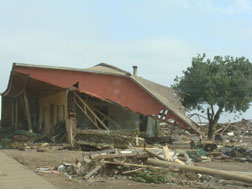NSF/IRIS/PASSCAL Supports Chile RAMP
The National Science Foundation, using its Rapid Response Research (RAPID) funding mechanism, is supporting a project to collect an open community dataset from a portable seismograph deployment in an aftershock study following the magnitude 8.8 earthquake that occurred off the coast of Chile on February 27, 2010. The IRIS Consortium, on behalf of its Member Institutions, will work with scientists from US universities and the University of Chile to deploy 60 broadband seismic instruments to record aftershocks for approximately six months. This community-wide coordinated approach will provide the best quality dataset that can be utilized immediately by a wide range of researchers from around the world.

The 2010 Chile earthquake is the fifth largest megathrust earthquake ever to be recorded and provides an unprecedented opportunity to advance our understanding of megathrust earthquakes and associated phenomenon. The earthquake ruptured a segment of the Nazca/South America plate boundary adjacent to and north of the great magnitude 9.5 1960 Chile earthquake - a segment that has a long history of large damaging earthquakes. A key concern is how far north the mainshock ruptured and why it terminated where it did. Additionally, this segment of the Chile subduction zone has similarities with Cascadia and Alaska, including shallow dip, sediments in the trench, and a history of great earthquakes, and could provide important information for comparative studies.
- Home
- General Information
- Instrumentation
- Dataloggers
- Sensors
- All-In-One Systems
- Power Systems
- Field Procedures
- Controlled Sources
- Seismic Source Facility
- Magnetotelluric Systems at PASSCAL
- Ground Penetrating Radar
- Power and Memory Calculations Form
- Data Archiving
- Apply for a PI Account
- Experiment Scheduling
- Polar
- Important Hardware/Software Notes
- USArray
- Software
Also See
- IRIS PASSCAL Supports Fluvial Seismology Research in Grand Canyon
- IRIS/PASSCAL Intern Cuts Her Teeth on TESGM Project Fieldwork
- SEIS-UK joins IRIS/PASSCAL on Support Effort for Antarctic Projects
- IRIS/PASSCAL Intern Caps Busy Summer with Alaska Deployment at Poker Flat
- PASSCAL Posters at 2014 IRIS Workshop, June 8-11, in Sunriver, Oregon

